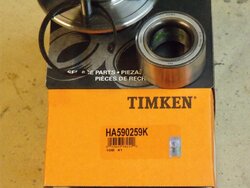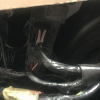lizardking228
Member
- Joined
- January 21, 2013
- Messages
- 12
- Reaction score
- 0
- Year, Model & Trim Level
- 2003 explorer
I posted this in the other part of the forum but thought I might try here too since this is the thread that I used. I really am stumped....
About a month ago I had my rear differential completely replaced on my 2wd 2003 Explorer with 130k miles. Two weeks later my original rear drivers side wheel bearing went bad and started grinding. So I replaced that (using a thread on this forum), and it went fine. A week later my original rear passenger side wheel bearing went bad and started grinding. So I replaced that, but immediately after replacing it (within driving 500-100 feet at 30-40 mph), the same rear passenger bearing started grinding and tearing itself up. It was completely ground up after driving a few thousand feet. So, I replaced it again, and again when I got up to 30-40 mph the bearing immediately went bad and ground up. I torqued the axle nut to 203 foot/lbs on both sides. The bearings were pressed by a well known reputable shop. What could be causing this?
Also to the above conversation, yeah, it's not just the bearing holding the wheel on there. When I took off my first replacement after I got the knuckle off I just lifted the hub completely out of the knuckle. There was no bearing left except the outer race and loose rollers lol. It was just disintegrated. Scary as crap to drive though at even 3mph the wheel was wobbling everywhere. I could see how that could break some stuff off like the lugs at high speed.
About a month ago I had my rear differential completely replaced on my 2wd 2003 Explorer with 130k miles. Two weeks later my original rear drivers side wheel bearing went bad and started grinding. So I replaced that (using a thread on this forum), and it went fine. A week later my original rear passenger side wheel bearing went bad and started grinding. So I replaced that, but immediately after replacing it (within driving 500-100 feet at 30-40 mph), the same rear passenger bearing started grinding and tearing itself up. It was completely ground up after driving a few thousand feet. So, I replaced it again, and again when I got up to 30-40 mph the bearing immediately went bad and ground up. I torqued the axle nut to 203 foot/lbs on both sides. The bearings were pressed by a well known reputable shop. What could be causing this?
Also to the above conversation, yeah, it's not just the bearing holding the wheel on there. When I took off my first replacement after I got the knuckle off I just lifted the hub completely out of the knuckle. There was no bearing left except the outer race and loose rollers lol. It was just disintegrated. Scary as crap to drive though at even 3mph the wheel was wobbling everywhere. I could see how that could break some stuff off like the lugs at high speed.














